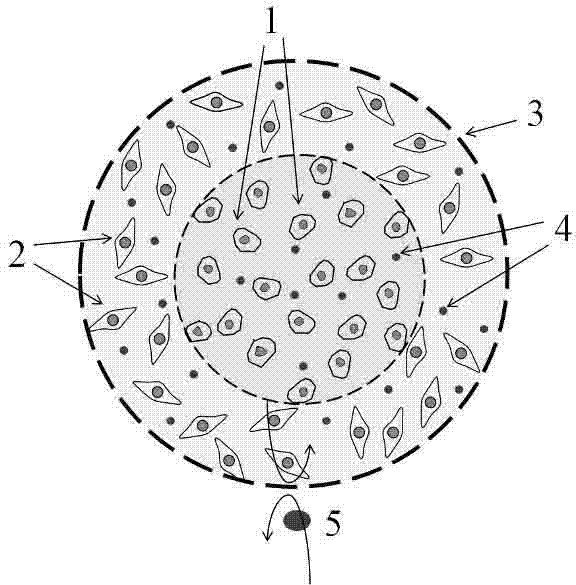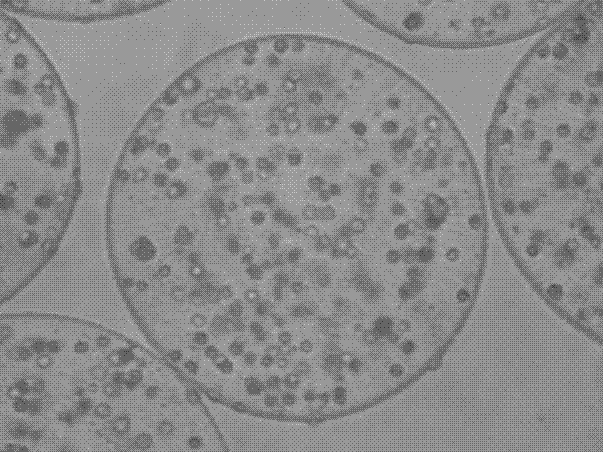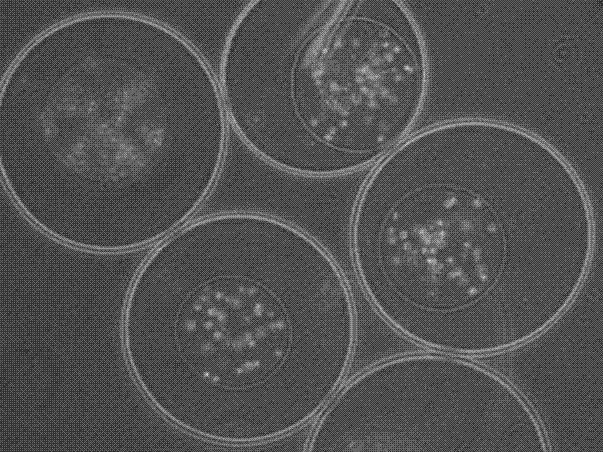Composite microcapsule model for use in in-vitro cell coculture
A co-cultivation and model technology, applied in the direction of tissue culture, immobilization on/in organic carriers, microorganisms, etc., can solve the adverse effects of cell morphology, functional expression biological characteristics, can not provide a three-dimensional space microenvironment, substrate materials The preparation process is cumbersome and other problems, to achieve the effect of simple equipment, reduced experimental cost, and small physical damage to cells
Active Publication Date: 2011-12-21
NANKAI UNIV
View PDF2 Cites 12 Cited by
- Summary
- Abstract
- Description
- Claims
- Application Information
AI Technical Summary
Problems solved by technology
However, this co-cultivation method is relatively complicated to operate, and the preparation process of the substrate material is relatively cumbersome, and it is limited to the co-cultivation of adherent cells, which greatly limits its application range.
At the same time, cells are still in a two-dimensional culture environment in this system, and the two-dimensional cell culture method cannot provide a three-dimensional space microenvironment similar to that required for cell growth in vivo, which will adversely affect many biological characteristics such as cell morphology and functional expression.
Method used
the structure of the environmentally friendly knitted fabric provided by the present invention; figure 2 Flow chart of the yarn wrapping machine for environmentally friendly knitted fabrics and storage devices; image 3 Is the parameter map of the yarn covering machine
View moreImage
Smart Image Click on the blue labels to locate them in the text.
Smart ImageViewing Examples
Examples
Experimental program
Comparison scheme
Effect test
Embodiment 1
Embodiment 2
Embodiment 3
the structure of the environmentally friendly knitted fabric provided by the present invention; figure 2 Flow chart of the yarn wrapping machine for environmentally friendly knitted fabrics and storage devices; image 3 Is the parameter map of the yarn covering machine
Login to View More PUM
| Property | Measurement | Unit |
|---|---|---|
| Particle size | aaaaa | aaaaa |
Login to View More
Abstract
The invention discloses a composite microcapsule model for use in in-vitro cell coculture. The model is a sphere-in-sphere composite microcapsule model consisting of an inner sodium alginate gel microsphere and an outer sodium alginate gel microsphere, which is formed by using natural polysaccharide sodium alginate as a substrate material, dripping the polysaccharide sodium alginate into multivalent cation solution and performing gelatinization treatment twice, wherein the two gel microspheres may contain two different kinds of cells. The model can be used for the study on in-vitro coculture of various cells and overcomes the drawback that the interaction between cells of the same kinds and the interaction between cells of different kinds cannot be controlled, the drawback that different kinds of cells are difficult to separate in late-stage study and the drawback that cell dependency exists of the conventional coculture model; and the model can simulate cell-cell interaction, cell-extracellular matrix interaction and cell-soluble factor interaction and provide theoretical and technical support for in-vitro construction of a tumor model, optimization of in-vitro culture mode of cells and tissue engineering construction of various tissue and organ analogues or equivalents.
Description
technical field [0001] The invention belongs to the field of cell in vitro culture technology, in particular to an animal cell in vitro co-culture model. Background technique [0002] In the body, cells are in a highly informational microenvironment filled with various complex physical and chemical signals, and cells respond to various signal stimuli to achieve their specific biological functions. The interaction between cells and this microenvironment includes various complex biochemical, biomechanical and bioelectrical signals from surrounding cells, extracellular matrix and soluble factors. Among them, the interaction between cells occurs through direct contact or paracrine soluble factors. This kind of intercellular communication is an important part of maintaining the structure and function of cells, tissues and organs, and it is also a key factor in regulating tissue repair and reconstruction in vivo and in vitro, and the lack of this kind of communication is the los...
Claims
the structure of the environmentally friendly knitted fabric provided by the present invention; figure 2 Flow chart of the yarn wrapping machine for environmentally friendly knitted fabrics and storage devices; image 3 Is the parameter map of the yarn covering machine
Login to View More Application Information
Patent Timeline
 Login to View More
Login to View More IPC IPC(8): C12N5/00C12N11/10C12N11/04C12N11/08
Inventor 毛宏理郑俊坤杨军
Owner NANKAI UNIV
Features
- R&D
- Intellectual Property
- Life Sciences
- Materials
- Tech Scout
Why Patsnap Eureka
- Unparalleled Data Quality
- Higher Quality Content
- 60% Fewer Hallucinations
Social media
Patsnap Eureka Blog
Learn More Browse by: Latest US Patents, China's latest patents, Technical Efficacy Thesaurus, Application Domain, Technology Topic, Popular Technical Reports.
© 2025 PatSnap. All rights reserved.Legal|Privacy policy|Modern Slavery Act Transparency Statement|Sitemap|About US| Contact US: help@patsnap.com



